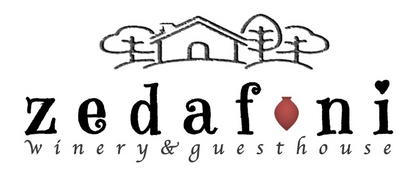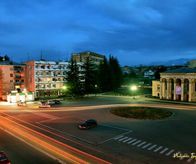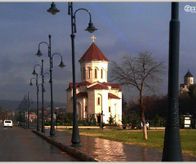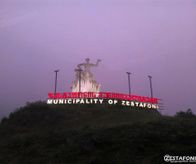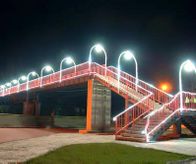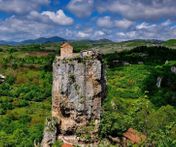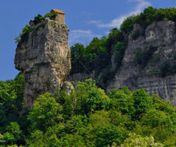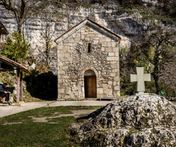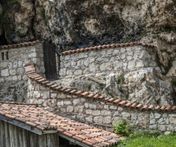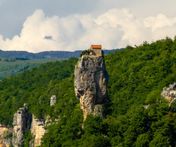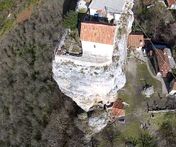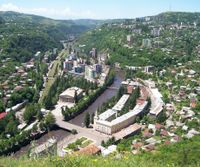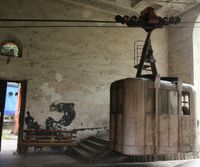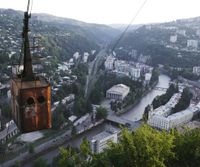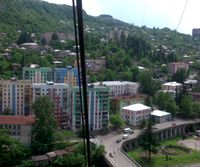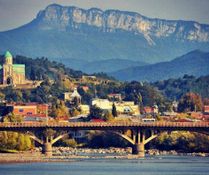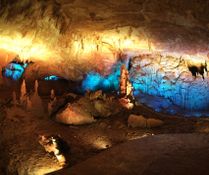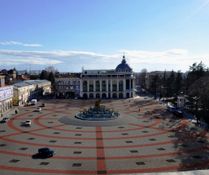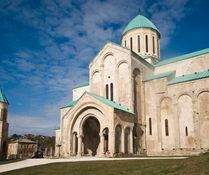Zestafoni
(Georgian: ზესტაფონი) is the administrative center of Zestafoni Municipality in Western Georgia. Zestafoni is the center of an ancient, historical part of Georgia – Margveti/Argveti province which is a part of Imereti Region. The town is situated in the furthest east of the Kolkheti Plateau and is built on the both banks of the river Kvirila. There are lots of historical monuments in the Zestafoni Municipality: Zeda Saqara (11th century), Tabakini (6th century), Tseva (11th century), Sanakhshire and other churches, castles from early Middle Ages in Shrosha and Shorapani. Shorapani (Sarapanis) is the toponymy, that is mentioned in old Greek mythology. That was Sarapanis that Jason and his Argonaut friends approached during their travel in old Colchis (Kolkhida).
The Katskhi pillar
(Georgian: კაცხის სვეტი, kac'xis svet'i) is a natural limestone monolith located at the village of Katskhi in western Georgian region of Imereti, near the town of Chiatura. It is approximately 40 metres (130 ft) high, and overlooks the small river valley of Katskhura, a right affluent of the Q'virila.
The rock, with visible church ruins on a top surface measuring c. 150 m2, has been venerated by locals as the Pillar of Life and a symbol of the True Cross, and has become surrounded by legends. It remained unclimbed by researchers and unsurveyed until 1944 and was more systematically studied from 1999 to 2009. These studies determined the ruins were of an early medieval hermitage dating from the 9th or 10th century. A Georgian inscription paleographically dated to the 13th century suggests that the hermitage was still extant at that time.
Chiatura
(Georgian: ჭიათურა) is a working landscape, dominated by mining operations and facilities. In this month-long course, participants were introduced to techniques of landscape research, analysis, interpretation, and design through intensive site exploration and artistic production. Due to the steep sided river valley, production workers spent a large amount of time walking up from the town to the mines, there by reducing productivity. In 1954 an extensive cable car system was installed to transport workers around the valley and up to the mines. Still utilising the same infrastructure installed originally in the 1950s, today some 17 separate aerial lift cable car systems still exist around the town.
Kutaisi
(Georgian: ქუთაისი) was the capital of the ancient Kingdom of Colchis. Archeological evidence indicates that the city functioned as the capital of the kingdom of Colchis as early as the second millennium BC. Several historians believe that, in Argonautica, a Greek epic poem about Jason and the Argonauts and their journey to Colchis, author Apollonius Rhodius considered Kutaisi their final destination as well as the residence of King Aeëtes
In the Jewish Quarter a number of synagogues demonstrate the long history of the Georgian Jewish community. The town’s largest synagogue, built in 1866, can seat 500 worshipers. The magnificent churches of Bagrati and Gelati – both UNESCO world heritages sites – testify to the importance of the region.
